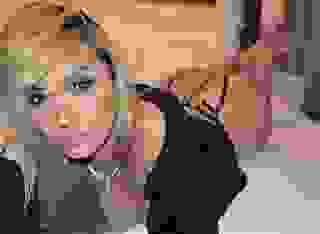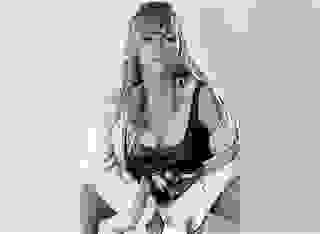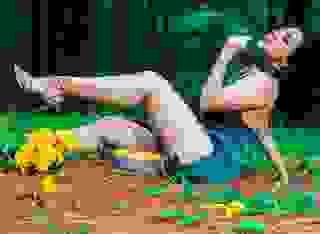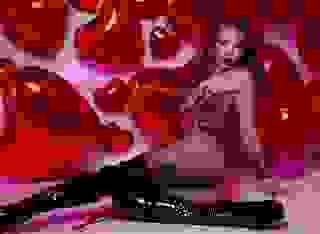- Erotic Horror
- In the Temple of Gar the Desecrator
Note: You can change font size, font face, and turn on dark mode by clicking the "A" icon tab in the Story Info Box.
You can temporarily switch back to a Classic Literotica® experience during our ongoing public Beta testing. Please consider leaving feedback on issues you experience or suggest improvements.
Click hereAll characters are 18 years of age or older.
*
It is with a heavy heart that I set out to commit these words to paper. Mine is not an easy tale to tell, and the reader will be forgiven for disbelieving this report, since it stretches credulity to beyond what even the most gullible would consider plausible. Furthermore, my words are all that I have, and no physical proof of any nature exists to lend substance to what I am about to relate here. Yet what follows is a truthful account of the events that have taken place, although there have been many occasions on which I have questioned my own sanity while reflecting upon them. However, being unable to properly assess the latter myself, I will have no choice but to trust in my recollection of what has occurred.
To begin this narrative without any further ado: I took part in expedition which departed from the archipelago at the southernmost edge of the South American continent in the year 1891. We planned our departure to take place shortly before the end of November, in hopes of making use of the clement weather prevalent in the Southern waters during these months. Our destination was the rocky isle due south of our point of departure, which had claimed the lives of so many intrepid sailors of late, and on which the crews of sundry passing ships have reported sighting unexplained flashes of light, eerie glows, sudden bolts of lightning and other mysterious phenomena that cannot be explained simply as being the result of bad weather, unskilled observation or an over-indulgence in grog or other such alcoholic restoratives to which a sailor may resort, so as to better withstand the rigors of a nightly watch in the frigid climes of the far South.
We sailed at first light on board of the schooner Intrepid: a sturdy three-master built but a few years earlier at the yards of Bath, Maine, and reinforced since against the possibility of encounters with ice in the frigid Southern seas by means of an iron cladding fitted to the bow and stern. Both weather and wind continued favorably, and in less than a week our objective appeared on the horizon.
I freely admit that, the first time I laid eyes on it, I felt an unreasoning fear. That black, foreboding pile of rock instilled in me a terror that I was entirely unable to explain. All I knew is that the sight of that rocky isle, which was essentially similar to any number of other formations found in these waters, caused me to have such feelings of cold dread as I have never experienced.
Our landing party consisted of six men including myself. Three of us were men of science, the others former members of the Her Majesty's Naval Service who, having become disillusioned with their careers, had since lent their services to the Society in hopes of expending them on more fruitful endeavors and had now been assigned to our expedition. Having a specialty in the natural sciences myself, I carried with me a number of instruments for the investigation of various phenomena, with the intention of finding the cause of the mysterious manifestation reported by passing sailors. My colleagues, Messrs. Thomas Delarousse and Robert Barstow, had brought on board their own equipment to aid them in their respective fields of geology and zoology. They hoped their endeavors would reveal the origins of the island and perhaps lead to the discovery of rare, strange or unknown creatures that might dwell on it.
With the Intrepid standing at anchor about half a mile off that forbidding shore, we loaded our scientific implements (packed in sturdy crates to protect them from the elements) into a dinghy along with tents, provender and the sundry supplies and equipment necessary to keep six men fed, sheltered and in relatively safety if not comfort for several days. Our naval companions Francis Gardner, William Jackson and Geoff Bradford proved their experience by quickly rowing us across and finding a sheltered cove with a small sandy beach, where we were able to go ashore with relative ease.
We unloaded the dinghy and carried our supplies and equipment up to a convenient plateau that we located behind the beach, sheltered from the elements and the incoming seas. Since it was rather early in the day and we felt we could leave our equipment safely, we decided to reconnoiter before making camp, traveling lightly and taking with us only what we expected to need on this first, cursory exploration. This was limited to sturdy boots for the lot of us, as well as some simple rock climbing gear and of course the various note books and pencils without which no self-respecting man of science would ever find himself. In addition to this, Bradford carried a rifle, while Jackson brought along a side arm.
The rocks proved more difficult to negotiate than we had expected. While our path from the beach up to the plateau offered relatively good footing across an easy slope, we soon found the rest of the island to be quite different. As we set out from what was to be our camp site, we found the rocks subsequently to be much larger and covered in a dark green, slimy ooze that not only proved treacherously slippery, but was also quite repulsive. My feelings of dread, which had abated since, returned in full force and, although none of us spoke about it, I could clearly see from the expressions on the faces of my companions that they had similar misgivings.
We paused briefly at the request of Thomas, who produced a rock hammer and proceeded to take some samples of the stone formations that surrounded us. By the time he put away the magnifying glass through which he had examined the chips thus liberated, he looked very troubled indeed.
"This is simply impossible!" he exclaimed. "These rocks are volcanic in origin. There has been no volcanic activity to produce them at this location for eons, yet these formations show virtually no signs of erosion. The rocks are also angular in shape, which is profoundly unnatural for material of this composition. I short, these formations should not exist. Yet they do!"
There was not much I could say to that, having little expertise in the field of geology. Robert Barstow, meanwhile, had deduced by now that his presence here would most likely be wasted, as the island appeared to be entirely devoid of anything of interest to the zoologist. We saw no signs of life whatsoever. There were no birds, nor crabs or mollusks, not even the small marine encrustations or fronds of sea weeds that usually adorn all rocks that are exposed to the waves. Why this was so, none of us could say.
As we continued on our way upward we entered a region where the shape of the rocks grew more regular, and gradually the going became easier. It was as if these higher strata of rock had been shaped and arranged, not by haphazard Nature but by a deliberate stonemason, although this Builder of Islands would have had to possess inhuman levels of strength and skill.
Then, in the course of our continued ascent, the air began to change in a very peculiar fashion. All around us we could see the waves of the wind-tossed sea, and the Intrepid, which stood at anchor not far off, moved with the winds and the waters as was its wont. Yet the air in which we now found ourselves became still and unmoving, the sounds of wind and water that until now had pervaded our environs becoming muted and distant. How this was possible I was unable to explain.
It goes without saying that we began to feel rather disquieted as this occurred. However, we were men of science and, confronted with phenomena which we were as yet unable to fathom, we felt compelled to proceed until an explanation would present itself. Yet none of us was surprised when Bradford unslung his rifle, and Jackson unholstered and cocked his pistol.
The wisdom of these precautions was confirmed when the rocks ahead of us revealed themselves to have been arranged in a straight path flanked by linear rows of stones, all equal in size: an arrangement that left no doubt as to its artificial nature. Stretching before us as it did, the black stone, adorned with its unwholesome green patina, exuded a sense of inexplicable anciency, and somehow we felt as if we were the first to set foot on it in a time so long as to be incomprehensible to the human mind.
We halted and regarded the prospect before us, but were unable to see for more than a few yards, since the remainder of the path was obscured by a peculiar pearly mist hanging in the inexplicably still air. We also detected a faint but distinct odor of ancient decay, as if the very stones themselves had produced this noisome exhalation.
We slowly continued forward. While we did find ourselves permeated by not a small sense of dread, we also felt compelled to proceed, as if an unseen force beckoned us and urged us on. Soon the mists surrounded us, the vapors cold and clammy upon our skins, a sensation reminiscent of what one feels when touching a corpse. I am sure that, had it not been for the strange compulsion under which we now found ourselves, we would all have turned back and, having reached our intended camp site and taken stock of the situation, perhaps even might have decided to quit the island entirely. As it was, we continued step by step through the mists across the wetly glistening surface that stretched before us. The path was completely straight and level now, paved with stone blocks that had been squared and fitted with a degree of precision that clearly bespoke the great lengths to which its builders had found it necessary to go in constructing it.
The mists became even denser and more oppressive, and before long we felt that we had departed the world from whence we came and strayed into an entirely different realm, one far removed from the comforting familiarity of the physical and rational and instead dominated by unseen forces, the nature of which we could not even begin to guess. To further this impression, a wan, eerie green glow slowly became visible ahead of us through the mists, and we felt our pace increase as we perceived what surely had to be our destination.
What appeared before us as we proceeded through the haze was an immense wall, stretching into the mists farther and higher than the limited visibility allowed one to see. It was absolutely straight and flat, and constructed from the same square stone blocks as was the path that led to it. However, this wall was possessed of a glow more intense than what emanated from the road. Furthermore, the sense of enormity it carried about it caused me to wonder how something of this size would not have been visible from afar, especially given the fact that no previous observation of the island had ever revealed any mist or fog of the order in which we now found ourselves.
Set into the wall was an entrance, framed by heavy, rectangular beams hewn from a rock rougher in texture and lighter in color than was the stone from which the wall and road were constructed. The vertical beams leaned inward, causing the entrance to be wider at the bottom than at the top, and the lintel that crowned them was a heavy slab, appearing more than capable of holding up the immense weight resting on it. However, it was not its size or massive appearance that drew my attention.
Chiseled into its face was some sort of writing, but of a variety I had never before encountered. It resembled in no way our own Latin-derived writing, nor did it bear any likeness to the curled script of the Middle East and North Africa, the ideograms of the Far East, or even the runes and hieroglyphs of old. Instead this script appeared completely alien, and there was something repulsive and unwholesome about its character; something reminiscent of spiders, roaches and other many-legged things that crawl about unseen in dark, dank places.
Yet what lay beyond this foreboding gate was not darkness. The peculiar luminescence that emanated from the wall and, to a lesser degree, from the road leading to it, was even stronger within the passage to which the gate gave entry. Although by no means brightly lit, and filled with the same misty haze that surrounded us in such a way as to limit the reach of the eye to a but a few yards in, the passage was by no means dark enough to require the use of torch or lantern.
To this very day I wish, more than anything, that we never had taken that first fateful step across the threshold. But the strange compulsion that had urged us on to this point still held, and we felt ourselves drawn into that nebulous green glow within. Had we but known what awaited us there! I am sure we would have easily overcome our urge to venture onward if we could have suspected the magnitude and intensity of the horrors that lay ahead. As it was, we cautiously entered the corridor, aided by the faint greenish illumination that emanated from the stone that surrounded us.
As the mists parted before our slow advance, they revealed a row of sculptures which were suspended from the walls on either side of the passage. We halted at the first one, and found it to be very peculiar indeed. It depicted a man, rendered in exquisite detail and carved from a smooth, black, glossy stone. A Phidias might have sculpted him, although no ancient art had ever included a work quite like this. Affixed to the wall in a spread-eagled position and completely naked, the man looked almost as if he had been crucified, although his arms were raised above the horizontal, so that his arms and legs formed a large letter 'X'. Heavy steel bands at the wrists and ankles secured the sculpture to the wall. Its head was thrown back so that it was looking up at the ceiling of the corridor, and its contorted face with the eyes closed and mouth open bore a tortured expression that suggested extreme agony.
But that was not the most peculiar aspect of the sculpture. Barring the artworks of an amorous nature found in bawdy houses and similar establishments of ill repute, and the reliefs adorning certain temples in India, no human form had to my knowledge ever been displayed in this particular state.
I feel I must utter a word of caution at this point, for what I am about to say may be deemed distasteful by some who read this account. However, in the interest of clarity and the accurate statement of fact, I must proceed in the most candid of manners, as the nature of the discoveries and events still ahead of us simply cannot be described with any degree of truth if I am to remain within the boundaries of civilized conversatioin. Moreover, this will apply not only to what I have to say here, but also to the remainder of this narrative. Therefore the reader should be prepared, as there is much worse yet to come. Yet the peculiar aspect that I must clearly state here is fully relevant, as it touches upon the matter of this report in ways that defy the imagination of a healthy mind. I will, therefore, have to dispense with the restrictions of good taste, and speak candidly.
That most singular aspect to which I refer concerned the state of the statue's manhood. It had been rendered fully engorged and erected, as if the sculptor had caught his subject at the height of physical arousal and, in response to some inexplicable lewd impulse, had chosen to depict him exactly in this condition.
Thomas bent down and touched the black stone. He ran his fingers across the smooth, almost glossy surface, then examined more closely the one of the steel bands that had been wrapped around it. He produced his magnifying glass and peered through it at the area where a small chip had been dislodged by the edge of the steel that anchored the statue to the wall.
"Most remarkable," he said. "This material is black, amorphous, and igneous. It is almost certainly obsidian, which is an exceedingly hard and brittle substance not often encountered in deposits this large without displaying fracture lines or other flaws. Obsidian sculptures therefore never have attained this size nor this level of detail. This is very strange indeed."
"That is not the most striking peculiarity," Gardner observed, as he regarded the statue's erect manhood. "Who would make something like this?" He doffed his hat and hung it on the rigid member as if the latter were a peg on a hat rack. "There, lad, that's better," he said. "At least you're half decent now."
"We may not have enough hats," Barstow cautioned him as he peered ahead into the gloom.
And indeed, it was only a few steps further until we encountered another, similar work of art. Like the first one, this one was also suspended in the same spread-eagled position and depicted in the nude, and its member was as rigid and engorged as had previously been the case. Yet this statue presented its own mysteries.
Whereas the first model was possessed of the classical features commonly found in sculpture and even had somewhat of a heroic bearing, the man who had stood for this depiction had been rather unremarkable. Slight in stature and lacking the muscularity or definition so characteristic of the usual subjects of art, the body of this man could at best be described as common. His face, although contorted in an expression of agony like that of the first statue, was lean, narrow and weathered, as if it had been exposed to the sun, winds and other rigors of outdoor life that so often mark the commoner. Why any sculptor would have chosen a model so uninteresting, especially given the singular way in which the work had been rendered, was something I was quite unable to explain.
Upon closer examination of this statue's erect member (an examination which, I freely admit, I performed out of curiosity more than for any other reason) I noticed something exceedingly odd. Apart from the size of the genital, which exceeded the endowment of the previous statue by a generous order of magnitude, there was a peculiar detail that caught my eye. Suspended from the tip of the sculpture's rigid manhood was a drop of its male essence, and the definition and accuracy with which this had been carved out of the glossy black stone was of such a delicacy that it caught and reflected the light in a way as to make it appear almost real. But why would the sculptor have gone to this great effort to render a detail of this nature so accurately, yet choose a commoner for his model?
Unable to answer these or any of the many other questions that puzzled us, we proceeded along the corridor, passing several more sculptures similar to the ones already described. While all models that had stood for these works appeared to have been drawn from different walks of life, each statue was suspended from the walls in a spread-eagled position, arms raised and legs spread, nude, and depicted in a high state of passionate arousal with its members engorged and fully erected, its face bearing one of a variety of contorted expressions.
Shortly thereafter there appeared before us out of the gloom another gate, glowing eerily green like the one through which we had entered the passage, yet the light emanating from this gate was subtly different: it had a quality about it that was, somehow, repulsive and unwholesome, giving rise to thoughts of diseased things that fester and rot in the dark unseen; suggesting mold and decay and putrefaction, and I am forced to admit that I felt the cold hand of fear around my heart once more. Yet the strange compulsion under which we operated held and, almost without noticing how much we were driven, we went forth toward this second doorway. It was similar in nature to the first, being framed in heavy, squared beams of stone, wider at the bottom than it was at the top, and crowned with a heavy lintel bearing the same spidery pothook script that adorned the one we had seen earlier.
The gate seemed to call to us. I realize this is a strange description for a man of science to give, but this is the best way I can put it into words. From it there seemed to emanate a sense of unspeakable delights awaiting us within, and we felt ourselves drawn to it. Yet we hesitated. Standing there, I'm sure we all were torn between attraction and revulsion, between the urge to proceed and the urge to withdraw. I know I was.








